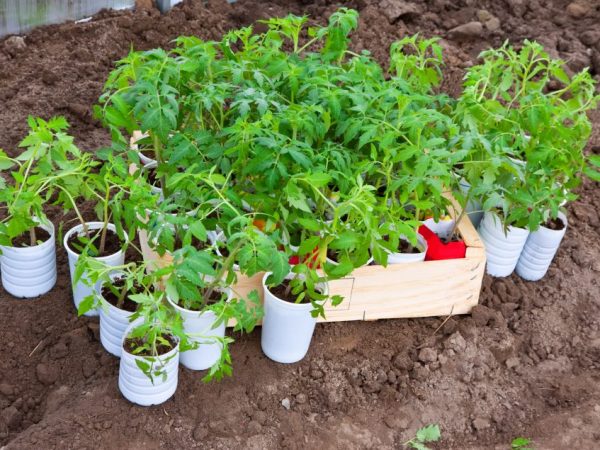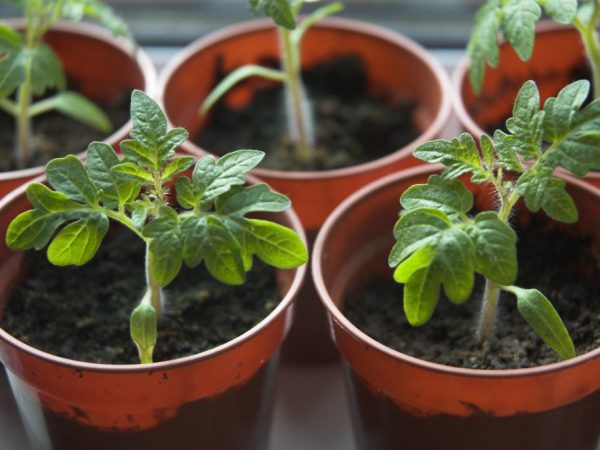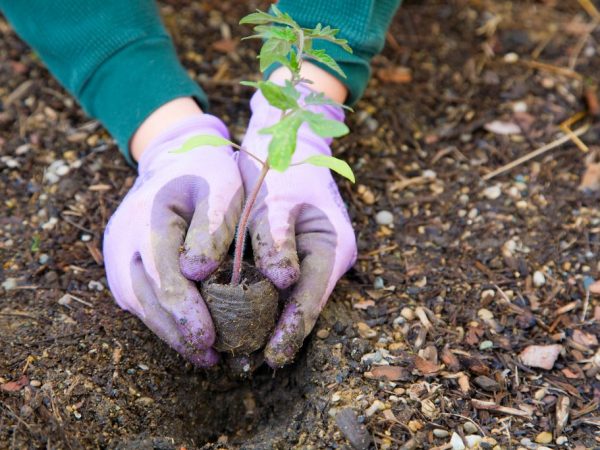Tomato seedling transplant rules
A large number of vegetable crops are grown in seedlings. This allows for early harvests. The gardeners begin the preparation process in March, and sometimes even earlier (if it is planned to plant the plants in heated greenhouses). Let's try to figure out how necessary a transplant of tomato seedlings is, when and how it should be done.

Tomato seedling transplant rules
Why are tomatoes transplanted
It is not necessary to make a pick when growing tomatoes in a seedling way. You can also sow seeds in large cups, where the seedlings are located until planting. Most often, sowing is carried out in trays or cassettes: on the one hand, it saves space on a room windowsill, balcony or in a small greenhouse, on the other hand, it creates the most favorable conditions for obtaining strong seedlings.
Growing seedlings with overly crowded plants tends to delay the start of the first harvest, resulting in a partial loss of the advantage of the seedling method.
Benefits of transplanting tomatoes:
- breakage of small lateral roots stimulates the growth of the seedling root system;
- a gradual increase in the area of plant nutrition contributes to an increase in productivity;
- diseased, damaged plants are removed;
- costs at the initial stage of growing tomatoes are minimized.
There are also disadvantages: an illiterate or untimely picking leads to a long-term adaptation of the transplanted plants, and therefore to a delay in fruiting.
Growing seedlings in a large container also has disadvantages. The soil that has not been mastered by the roots of the plant turns sour. For tomatoes, neutral soils are most suitable, acidic ones contribute to a decrease in immunity.
In vegetable growing, there is such a concept as the coefficient of the deployment of the area when picking. This is a number that shows how many times more area the plants will occupy after picking in comparison with the one they occupied before. For example, for cabbage, this coefficient is 5-7, and for tomato, pepper and eggplant - 8-10.
First pick
When to transplant
A tomato transplant is carried out when the seedlings have formed the first pair of true leaves. This usually happens 15-17 days after germination. Gardeners recommend keeping it for a few more days so that the stem of the plant is strengthened and the root system becomes more powerful. Most often this happens by 18-12 days.
It is undesirable to skip deadlines, because the rapidly developing roots of the seedlings will intertwine. During transplantation, they are seriously damaged - the growth retardation can be a week or more.
The calendar of sowing seeds and transplanting tomato seedlings into the ground will be different for everyone. It depends on where the tomatoes are planted (in open ground without shelter or under temporary shelter or in a greenhouse); what are the climatic conditions of the place of residence.
The calculation is simple: early tomatoes have a growing season of 90-100 days. You need to transplant tomato seedlings to a permanent place at the age of 50 days.If you plan to plant tomatoes in a greenhouse at the end of April, you need to sow at the beginning of March (counting 50 days plus a week for seed germination).
During the dive, the seedlings are immersed in the ground deeper than they grew. Additional roots are quickly formed from the hypocotal knee.
What to plant
As containers for diving, you can use ordinary disposable plastic cups with a volume of 150-170 ml. Glasses with a drainage hole are placed on a pallet.

It is better to transplant plants into special soil.
It is not recommended to use pure garden soil. Soil for seedlings is specially prepared:
- mix peat, sand and rotted compost, taken in equal proportions;
- for improvement, the soil is sifted through a coarse sieve;
- disinfect the mixture by steaming in the oven, in a water bath or freezing;
- to increase soil fertility, add a pinch of superphosphate and potassium sulfate, a little vermicompost (sold in the retail network).
A good result is the use of a hydrogel - polymer chips that absorb moisture during watering, and then gradually give it back. If you add a little hydrogel under the roots of the seedling when transplanting, you can not be afraid of stagnant water or dry out the soil, reduce the number of watering to a minimum.
How to transplant
For a day or two, before transplanting tomato seedlings, it is watered. If this is not done, the dry soil will not hold onto the roots, and they will take longer to take root. When the soil is moistened immediately before the procedure, the soil forms heavy clods, which, breaking off, also damage the root system. The best option is when the seedling is transferred to a new place with a small clod of earth that is easily held by the roots.
For careful extraction of plants from the common tray, use a toothpick (small knife), with which the bush is separated from the land mass. It is better to hold the plant closer to the root lobe so as not to damage the green part. A glass for young tomatoes is filled with earth by 2/3, a depression is made, water is poured into it, and then the seedling is placed there.
There is another option. You need to make a large depression in the soil: place a pencil in the center of the glass and make circular movements several times, increasing the diameter of the circle, transfer the seedling and only then pour water. In this case, the flow of water straightens the roots, deepens the bush, it remains only to compact the earth around the stem.
As the bush grows, the soil can be poured, creating conditions for the formation of additional roots. They also act in a different way: the stem is buried to the cotyledonous leaves.
Should you pinch the central root of tomatoes when transplanting seedlings? Some recommend pinching off a third part to stimulate the growth of the root system. Others believe that the root at the age of 18-20 days is too thin and in the vast majority of cases is damaged without much effort.

Handle your seedlings with care
There is no great need to cut the cotyledon leaves, because they dry up on their own at a certain stage of plant growth. Pruning creates additional difficulties during the adaptation period.
Features of seedling care
After the first transplant, tomatoes need special conditions:
- observance of the temperature regime: the optimal daytime temperature is 18-22 ° С, nighttime - not lower than 16 ° С;
- sufficient lighting (lack of it will lead to the fact that the plant will stretch out, and the flower cluster is formed not after 5-6 leaves, but later, which will delay the onset of fruiting);
- timely watering (the first - not earlier than a week after the pick, while it is important not to overdo it, since excess moisture leads to oxygen starvation, slowing down of development).
A small container over time can lead to inhibition of seedling growth. If two transplants were planned before disembarking to a permanent place, it is necessary to make a second one in time.In order not to miss the deadline, at the first pick, 2-3 control bushes are immediately planted in a large container. If the bulk of the seedlings has stopped growing, is lagging behind the control ones, it is time to hurry up with transplanting into a large container or to a permanent place.
After transplantation, tomatoes are fertilized in 10-14 days. For feeding, use niftrophoska (nitroammofoska): 1 tbsp. l. diluted in 10 liters of warm water.
Second pick
It is recommended to dive for the second time 3 weeks after the first: this way you can avoid pulling and form a powerful root system of tomatoes.
Key recommendations:
- transplant into a container that is twice the volume of the original container;
- use the transshipment method (this does not injure the roots, does not waste time on adaptation);
- do not place the plants in direct sunlight during the first days.
Watering and fertilizing is carried out in the same way as after the first pick. Rooted plants must be hardened. To do this, they are taken outside for 3 hours daily if the air temperature does not drop below 12 ° C.
A pick takes a lot of time and money. Therefore, it is impractical to grow tomato seedlings with a double pick.
When are tomato seedlings transplanted into open ground? Optimal terms: early - at the age of 45-50 days, the rest - 55-60. External signs of readiness: a thick stem, a powerful root system, the first flower cluster formed. There is an opinion that flowering tomatoes cannot be transplanted: they will grow poorly, however, such bushes take root no worse during transshipment.
Conclusion
It is believed that transplanting tomatoes in containers of different sizes has a beneficial effect on their growth and development. In order to guarantee a high and early harvest, you need to carry out all procedures on time and correctly, from soil preparation to the appearance of the first fruits.


